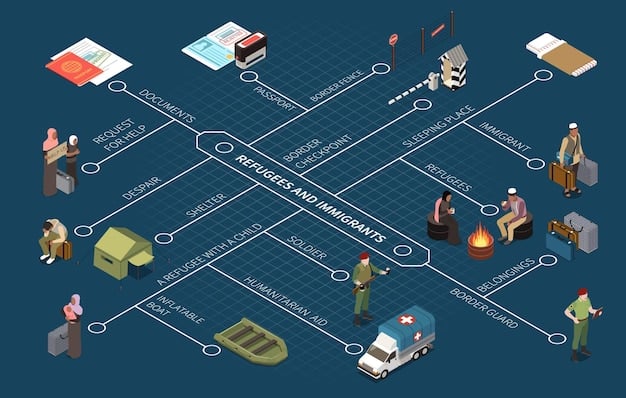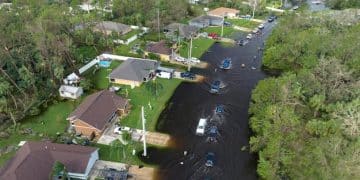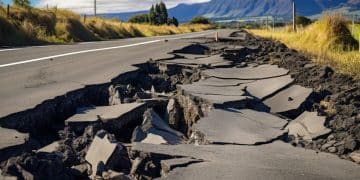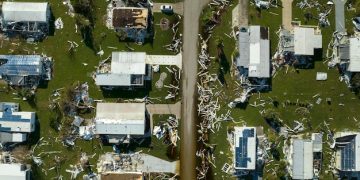Navigate FEMA Individual Assistance: 2025 Step-by-Step Guide

The FEMA Individual Assistance program is a vital lifeline for people rebuilding after disasters in 2025. It offers financial help and direct support to those facing loss and uncertainty.
Understanding how FEMA Individual Assistance works can make recovery faster and less stressful. This guide explains how to apply, what to expect, and how to secure the aid you need.
If disaster strikes, knowing how to navigate FEMA Individual Assistance could be the key to getting your life back on track.
Understanding FEMA Individual Assistance
The FEMA Individual Assistance (IA) Program serves as a crucial federal support system, offering aid to individuals and families whose homes and essential belongings have been damaged or destroyed by a declared major disaster.
It’s not a substitute for insurance, but rather a safety net designed to help bridge gaps and offer critical support when other resources are insufficient.
Understanding the core components of this program is the first vital step in accessing the help you need. Disasters, whether natural or man-made, can inflict severe and widespread damage.
While immediate rescue efforts focus on saving lives, the long-term recovery often depends on structured assistance programs.
FEMA Individual Assistance provides funding for various needs, from housing assistance to medical and funeral expenses, offering a comprehensive approach to post-disaster recovery.
Key components of the program
FEMA Individual Assistance is structured around several aid types, each addressing specific needs that arise after a disaster.
Familiarizing yourself with these categories will help you understand what kind of support might be available and if your situation qualifies.
- Housing assistance: This is a cornerstone of the IA program, offering either financial aid for temporary housing (like rental assistance) or funds for home repair and replacement if the damage renders the residence uninhabitable.
- Other Needs Assistance (ONA): ONA covers essential expenses not directly related to housing but crucial for recovery. This can include assistance for medical and dental costs incurred due to the disaster, essential personal property replacement, and even funeral expenses in tragic cases.
- Disaster Unemployment Assistance (DUA): For those who have lost their jobs or self-employment as a direct result of a major disaster, DUA provides financial assistance until they can return to work or for a specified period, offering a crucial safety net.
Beyond these financial aid types, FEMA also coordinates with other federal agencies to provide direct services, such as crisis counseling and legal aid, further supporting survivors through the recovery process.
The program aims to address both immediate and long-term needs, ensuring a more comprehensive path to stability.
Being aware of these components allows you to better assess your situation post-disaster and determine which aspects of the IA program align with your recovery needs.
It’s important to remember that eligibility is often based on the severity of damage and the specific disaster declaration.

Eligibility criteria and disaster declaration
Before you can apply for FEMA Individual Assistance, two fundamental elements must be in place: a presidential disaster declaration that includes Individual Assistance, and your personal eligibility.
Without a declaration for IA in your county or parish, FEMA cannot provide individual financial aid, regardless of your personal circumstances. This declaration is the trigger for all federal aid to individuals.
A presidential disaster declaration is the formal recognition by the President of the United States that a disaster is beyond the capabilities of state and local governments to respond.
For Individual Assistance to be available, the declaration must specifically authorize it for your affected area.
This is a crucial distinction, as a declaration might cover Public Assistance (aid to governments) but not Individual Assistance.
Determining your eligibility
Once a disaster declaration for Individual Assistance is made for your area, the next step is to understand if you, as an individual or household, meet FEMA’s specific eligibility requirements.
These criteria are designed to ensure aid reaches those who genuinely need it and have no other means of recovery.
- Residency: You must be an authorized resident of the United States, a U.S. citizen, non-citizen national, or qualified alien. Residency in the disaster-declared area is also a key factor.
- Damage specificity: Your primary residence must have sustained damage or destruction as a direct result of the declared disaster. This means secondary homes or vacation properties typically do not qualify for IA.
- Insurance considerations: FEMA aid is often considered after insurance settlements. You must apply for insurance first, and FEMA will then assess needs that insurance doesn’t cover. This is a “last resort” philosophy, meaning FEMA supplements, rather than replaces, other forms of assistance.
FEMA will also consider if the damaged property was your primary residence at the time of the disaster.
Documentation such as utility bills, driver’s licenses, or tax records can help prove residency. The agency also assesses the severity of the damage, often through inspections, to determine the level of assistance required.
Understanding these eligibility parameters early on can save significant time and effort during the application process.
It also helps manage expectations about what the program can and cannot provide. If you’re unsure about your status, it’s always best to apply and let FEMA make the determination.
The application process: Step-by-step directions
Applying for FEMA Individual Assistance can initially seem complex, but by breaking it down into manageable steps, you can navigate the process more effectively.
The key is to act promptly, gather necessary documentation, and accurately provide all requested information. This section outlines the essential phases of the application, ensuring you cover all bases.
Step 1: Register for assistance
The first and most critical step is to register with FEMA. This is the official gateway to all potential individual assistance.
You have several convenient options for registration, making it accessible even in challenging post-disaster conditions.
- Online: The quickest and often most efficient method is to register online at DisasterAssistance.gov. This website is user-friendly and guides you through the application questions.
- Phone: You can call the FEMA toll-free helpline at 1-800-621-FEMA (3362). This option is good for those without internet access or who prefer speaking directly with a representative. For individuals who use TTY, call 1-800-462-7585.
- Mobile App: The FEMA mobile app, available for smartphones, also provides a direct registration portal and other useful disaster resources.
When you register, have essential information on hand: your Social Security number, current and pre-disaster contact information, insurance policy information, and details about the damage and losses you sustained.
This initial registration is crucial as it creates your application record.
Step 2: Documentation and information gathering
Once registered, the next phase involves collecting and organizing all necessary documents to support your claim.
The more complete and accurate your information, the smoother the process tends to be. This stage is about proving your identity, residency, and the extent of your losses.
Key documents you should prepare include:
- Proof of identity: Government-issued ID, driver’s license, etc.
- Proof of occupancy/ownership: Lease agreement, utility bills, mortgage statements, property deeds.
- Insurance information: Policy numbers for homeowner’s, renter’s, or flood insurance, alongside details of any claims filed, including settlement amounts.
- Damage evidence: Photos or videos of damage, receipts for repairs, estimates from contractors.
- Financial documentation: Bank account numbers for direct deposit of funds.
It’s advisable to create copies of all documents and store them in a secure, accessible location.
Digital copies are also highly recommended. This meticulous preparation minimizes delays and provides a clear record of your circumstances.
Step 3: FEMA Inspection
After your initial registration, FEMA typically dispatches an inspector to verify the damage to your primary residence.
This inspection is a critical step in determining the type and amount of assistance you may receive. An inspector will assess the damage to your home and belongings, confirming what you reported during registration.
During the inspection, be prepared to show the inspector all damaged areas and items. Provide any supporting documentation you have, such as photos taken immediately after the disaster.
It is essential to be present during this inspection or have an authorized representative available. The inspector will not determine your eligibility or the amount of aid; they are solely there to document the damage.
This verification process ensures that aid is properly distributed based on actual needs.
The inspector’s report is then submitted to FEMA, where it becomes a crucial part of the decision-making process regarding your application.
Understanding your application status and decision
After you’ve registered and an inspection (if necessary) has been conducted, the waiting period begins.
This can be a time of anxiety, but understanding how to check your application status and what to expect from FEMA’s decision can help you navigate this phase.
Transparency in the process is key to ensuring you are informed.
Checking your application status
FEMA provides several straightforward ways to monitor the progress of your application. Consistent checking can help you identify if additional information is needed or if a decision has been made.
- Online: The most efficient way to track your application is through your account on DisasterAssistance.gov. Simply log in with your credentials, and you’ll find real-time updates.
- FEMA Helpline: You can also call the FEMA toll-free hotline at 1-800-621-FEMA (3362). Be ready to provide your registration ID number.
- FEMA App: The mobile app also offers status updates directly on your device.
It’s important to regularly check your status for any requests for additional information. Delays in providing requested documents can significantly prolong the decision-making process.
FEMA aims to process applications as quickly as possible, but high volumes after large-scale disasters can impact timelines.
Receiving your decision letter
Once FEMA has processed your application, you will receive a decision letter by mail or electronically. This letter is crucial as it details FEMA’s determination regarding your eligibility for assistance.
It will outline whether you are approved, disapproved, or require further action.
If you are approved, the letter will specify the type and amount of assistance you will receive, as well as information on how the funds will be disbursed (typically via direct deposit or check).
It may also include details on how the funds can be used. If your application is disapproved, the letter will clearly state the reason for the denial.
Common reasons include: lack of sufficient damage, primary residence not affected, insurance coverage already meeting needs, or missing documentation.
It is vital to read this letter carefully, as it will inform any subsequent steps you might need to take, such as an appeal.
Understanding the decision letter is paramount. It’s not uncommon for initial applications to be denied, especially if some information was missing or misunderstood.
The reason for denial often provides the exact pathway for a successful appeal.

The appeals process: What to do if denied
A denial from FEMA is often not the final word. Many initial denials are due to missing information, misunderstandings, or the need for additional documentation.
Understanding the appeals process is crucial for anyone who believes they were wrongly denied assistance. It provides a formal avenue to present new information or clarify existing circumstances.
It’s common for applicants to feel disheartened after a denial. However, the appeals process is designed to be accessible and provides a second chance to demonstrate your eligibility.
The key is to meticulously address the reasons for the denial as stated in FEMA’s decision letter.
Steps for filing an appeal
If you decide to appeal FEMA’s decision, there are specific steps you must follow to ensure your appeal is considered. Adhering to deadlines and providing comprehensive information are critical for a successful outcome.
- Understand the Reason for Denial: Carefully read your FEMA decision letter. It will state why your application was denied. This is the most important step, as it guides your appeal strategy. Reasons can include insufficient damage, primary residence not affected, insurance proceeds covering losses, or missing documentation.
- Gather Supporting Documentation: Collect all relevant documents that address FEMA’s reason for denial. For example, if denied due to “insufficient damage,” provide contractor estimates, receipts for repairs, or additional photos/videos. If “proof of occupancy” was the issue, include utility bills or a lease agreement.
- Write an Appeal Letter: Compose a clear, concise appeal letter.
- State your name, current address, disaster number, and FEMA registration number.
- Clearly explain why you believe the initial decision was incorrect. Reference specific points from the denial letter and explain how the new information or clarification addresses them.
- Be polite, factual, and avoid emotional language.
- Submit Your Appeal: Your appeal letter and all supporting documents must be postmarked within 60 days of the date on FEMA’s decision letter.
- Retain Copies: Always keep copies of everything you send to FEMA for your records. Consider sending the appeal via certified mail with a return receipt to confirm delivery.
- The appeals process can take time, but it’s a vital part of ensuring fairness and accuracy in assistance distribution. Many successful applications are the result of a well-prepared and timely appeal.
Avoiding common pitfalls and maximizing your aid
Navigating the FEMA Individual Assistance Program can present several challenges, and understanding common pitfalls can significantly improve your chances of a successful application.
Being proactive and meticulous with your application can save you time, stress, and potentially secure more comprehensive aid.
Mistakes to avoid
Even with a clear guide, applicants can inadvertently make errors that delay or jeopardize their eligibility. Being aware of these common mistakes can help you prepare more effectively.
- Missing deadlines: The 60-day deadline for appeals is strict. Failing to register or appeal within the specified timeframe can result in losing eligibility. Mark your calendar and act promptly.
- Incomplete information: Providing partial or incorrect information during registration or inspections is a leading cause for denial. Double-check all details, especially Social Security numbers, addresses, and insurance policy numbers.
- Discarding damaged items too soon: Do not throw away damaged items or make extensive repairs before FEMA has had a chance to inspect them or before you have thoroughly documented them with photos/videos. This evidence is crucial for assessing loss.
- Not appealing a denial: Many applicants give up after an initial denial. As mentioned, appeals are frequent and often successful if new or clarified information is provided. Don’t assume a “no” is final.
- Misunderstanding primary residence rules: FEMA assistance is primarily for your primary residence. Applying for a vacation home or secondary property is a common mistake that leads to denial.
Each of these pitfalls can derail an otherwise valid claim. Attention to detail and adherence to guidelines are paramount throughout the entire process, from initial registration to any subsequent appeals.
Tips for maximizing your aid
Beyond avoiding errors, there are proactive steps you can take to strengthen your application and potentially maximize the aid you receive.
These tips focus on thorough documentation, communication, and understanding the scope of available assistance.
- Document everything: Before and after photos/videos of damage, detailed lists of damaged personal property, receipts for temporary repairs, hotel stays, and other disaster-related expenses. The more evidence you have, the stronger your case.
- Keep a disaster journal: Maintain a log of all communications with FEMA, including dates, times, names of representatives, and summaries of conversations. This helps create a clear timeline and reference.
- File insurance claims promptly: FEMA aid is secondary to insurance. File your insurance claims immediately and keep detailed records of your insurance company’s response, including settlement amounts or reasons for denial.
- Seek assistance from disaster recovery centers (DRCs): If available in your area, DRCs offer in-person assistance, with representatives from FEMA and other agencies who can help with applications, answer questions, and provide guidance.
- Ask for clarification: If you are unsure about any part of the application or a request from FEMA, call the helpline or visit a DRC. Don’t guess or provide incorrect information.
By diligently following these best practices, you empower yourself to navigate the FEMA Individual Assistance
Program more effectively, increasing your likelihood of receiving the full support you’re entitled to for your disaster recovery.
Future outlook and program evolution
As disaster landscapes continue to evolve, so too does the FEMA Individual Assistance Program.
For 2025 and beyond, FEMA is continuously looking for ways to streamline processes, enhance equity, and adapt to the increasing frequency and intensity of climate-related events.
Understanding these ongoing developments can help future applicants and communities prepare.
The agency is often responsive to feedback from previous disaster operations, implementing changes that aim to make aid more accessible and efficient.
This includes leveraging new technologies and improving coordination with state, local, and tribal partners to ensure a more integrated response and recovery effort.
Anticipated changes and focus areas for 2025
While specific policies are subject to ongoing review and legislative action, several trends indicate FEMA’s likely focus for the IA program in 2025:
- Enhanced Digital Accessibility: Expect continued enhancements to the DisasterAssistance.gov platform and the FEMA mobile app, aiming for even more user-friendly interfaces and expanded capabilities for document submission and status tracking. The goal is to reduce reliance on paper applications and make the process more accessible from remote locations.
- Focus on Equity and Underserved Communities: FEMA is increasingly prioritizing equitable access to aid. This may involve targeted outreach, simplified language materials, and increased support for communities that have historically faced barriers in accessing federal assistance, including those with limited English proficiency or unique cultural needs.
- Streamlined Damage Assessments: The agency is exploring technologies like satellite imagery and AI-assisted damage assessment to potentially expedite initial evaluations, reducing the need for on-site inspections in some cases and speeding up the delivery of initial assistance.
- Pre-Disaster Preparedness Integration: While IA is a post-disaster program, there’s a growing emphasis on intertwining recovery with resilience. Future program adjustments might subtly encourage or facilitate minor mitigation efforts during the repair phase, aiming to reduce future vulnerability.
These anticipated changes reflect FEMA’s commitment to continuous improvement.
The goal remains to provide timely and effective assistance to survivors, helping them rebuild their lives and communities with greater resilience.
Staying informed about these evolving policies through official FEMA channels will be beneficial for anyone planning ahead or facing future disaster events.
| Key Point | Brief Description |
|---|---|
| 🏠 Get Started: Register ASAP | Register online at DisasterAssistance.gov or by phone. This is the first essential step. |
| 📑 Document Everything | Keep detailed records: photos, receipts, and communication with FEMA and insurance. |
| 🤝 Appeal If Denied | Don’t give up if denied; read the denial letter carefully and submit a timely appeal with new info. |
| 💡 Stay Informed | Regularly check your application status and stay updated on FEMA policy changes. |
Frequently Asked Questions (FAQ) about FEMA Individual Assistance
Eligibility for FEMA Individual Assistance is primarily for U.S. citizens, non-citizen nationals, or qualified aliens whose primary residence is in a presidentially declared disaster area for Individual Assistance. Furthermore, the damage must stem directly from the declared disaster, and needs not covered by insurance are considered.
It is strongly recommended to apply as soon as possible after a presidential disaster declaration. While there’s typically a 60-day window from the declaration date for your area to register, applying promptly ensures a faster processing time and access to potential aid when it’s most critically needed for recovery. Delays can impact available resources.
FEMA Individual Assistance provides various types of aid, including financial assistance for housing (rental assistance, home repair/replacement), and other needs (such as medical/dental, funeral, essential personal property replacement, transportation, and childcare expenses). It also includes Disaster Unemployment Assistance and referrals to other vital programs.
FEMA assistance is generally considered secondary to insurance. You must first file a claim with your insurance company. FEMA may then provide aid for needs that your insurance does not cover, or for uninsured losses exceeding your policy limits. Always provide FEMA with your insurance settlement information when available.
Yes, you absolutely can appeal a FEMA decision. If your application is denied, carefully review the denial letter to understand the reason. You typically have 60 days from the date of the decision letter to submit a written appeal with new information or documentation that addresses FEMA’s stated reason for denial. Many appeals are successful.





